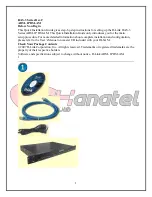
Intel
®
81341 and 81342 I/O Processors
December 2007
Developer’s Manual
Order Number: 315037-002US
731
Exception Initiator and Boot Sequence—Intel
®
81341 and 81342
10.2.1
Core Identity
Each core supports a 4-bit field in a co-processor register (CIDR) that contains a unique
core identification number (coreID). Refer to
Section 447, “Core Identification Register
. On the 81341 and 81342 there are two cores with assigned
coreIDs of 0H and 1H. On 81348ArnoldVal Vista the Application core has a coreID equal
to 1H, and the Transport core has a coreID equal to 0H. The coreID is also used by
hardware to indicate a targeted core for an event.
10.2.2
Targeted Reset
Each core can initiate a reset to the another core, including itself by writing a co-
processor register, Targeted Reset Register (TARRSTR) located in CP6. Refer to
450, “Targeted Reset Register — TARRSTR” on page 738
. TARRSTR register provides a
4-bit field for the coreID that is the target of the reset. By simply writing the TARRSTR
register with the appropriate coreID will initiate a reset to the targeted core. The reset
logic will assert and de-assert the reset signal to the targeted core for the required
duration. For example, software does not have to take any further action after writing
the TARRSTR register. In addition to the TARRSTR register, each core also provides
another co-processor register, Reset Cause Status Register (RCSR). Refer to
448, “Reset Cause Status Register — RCSR” on page 736
. This register provides a
mechanism for software to identify the cause of the a reset — for example, a system
reset or a core initiated reset. Bit 0 of the RCSR register is cleared when the core is
reset due to a system reset, and is set when the core is reset due to a targeted reset.
10.2.3
Inter-Processor Interrupt Generation
Each core can initiate software interrupts to another core, including directing the
interrupts to itself by writing a co-processor register, Core Interrupt Generation
Section 449, “Software Interrupt Generation Register —
. CINTGENR register provides a 4-bit field and an 5-bit field,
which contain the targeted coreID number and an interrupt source number (ISN)
respectively. On81341 and 81342 only five bits are implemented for the interrupt
source number, thus allowing up to thirty-two unique interrupt source numbers that
can be generated by a given core. By simply writing the CINTGENR register with the
appropriate coreID and ISN will generate an interrupt to the targeted core. In addition
to the CINTGENR register, each core also provides another co-processor register
(IPIPNDR) in the Interrupt Controller Unit where Core generated interrupts are posted.
For example, the 5-bit ISN is decoded and the corresponding bit in the IPIPNDR
register is set. Bit 0 is set when ISN is equal to 00H, bit 1 is set when ISN is equal to
01H, and so on. Software must write 1’s to clear pending interrupt bits in the IPIPNDR.
















































